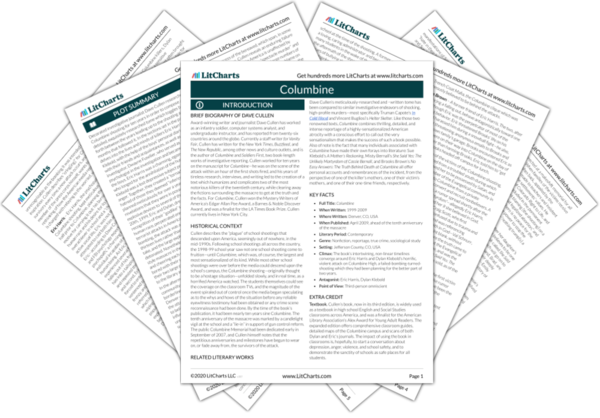Brief Biography of Dave Cullen
Award-winning writer and journalist Dave Cullen has worked as an infantry soldier, computer systems analyst, and undergraduate instructor, and has reported from twenty-six countries around the globe. Currently a staff writer for Vanity Fair, Cullen has written for the New York Times, Buzzfeed, and The New Republic, among other news and culture outlets, and is the author of Columbine and Soldiers First, two book-length works of investigative reporting. Cullen worked for ten years on the manuscript for Columbine—he was on the scene of the attack within an hour of the first shots fired, and his years of tireless research, interviews, and writing led to the creation of a text which humanizes and complicates two of the most notorious killers of the twentieth century, while clearing away the fictions surrounding the massacre to get at the truth and the facts. For Columbine, Cullen won the Mystery Writers of America’s Edgar Allan Poe Award, a Barnes & Noble Discover Award, and was a finalist for the LA Times Book Prize. Cullen currently lives in New York City.
Historical Context of Columbine
Cullen describes the “plague” of school shootings that descended upon America, seemingly out of nowhere, in the mid-1990s. Following school shootings all across the country, the 1998-99 school year saw not one school shooting come to fruition—until Columbine, which was, of course, the largest and most sensationalized of its kind. While most other school shootings were over before the media could descend upon the school’s campus, the Columbine shooting—originally thought to be a hostage situation—unfolded slowly, and in real time, as a horrified America watched. The students themselves could see the coverage on the classroom TVs, and the magnitude of the event spiraled out of control once the media began speculating as to the whys and hows of the situation before any reliable eyewitness testimony had been obtained or any crime scene reconnaissance had been done. By the time of the book’s publication, it had been nearly ten years sine Columbine. The tenth anniversary of the massacre was marked by a candlelight vigil at the school and a “lie-in” in support of gun control reform. The public Columbine Memorial had been dedicated early in September of 2007, and Cullen himself notes that the repetitious anniversaries and milestones have begun to wear on, or fade away from, the survivors of the attack.
Other Books Related to Columbine
Dave Cullen’s meticulously-researched and –written tome has been compared to similar investigative endeavors of shocking, high-profile murders—most specifically Truman Capote’s
In Cold Blood and Vincent Bugliosi’s
Helter Skelter. Like those two renowned texts,
Columbine combines thrilling, detailed, and intense reportage of a highly-sensationalized American atrocity with a conscious effort to call out the very sensationalism that makes the success of such a book possible. Also of note is the fact that many individuals associated with Columbine have made their own forays into literature: Sue Klebold’s
A Mother’s Reckoning, Misty Bernall’s
She Said Yes: The Unlikely Martyrdom of Cassie Bernall, and Brooks Brown’s
No Easy Answers: The Truth Behind Death at Columbine all offer personal accounts and remembrances of the incident, from the perspective of one of the killer’s mothers, one of their victim’s mothers, and one of their one-time friends, respectively.
Key Facts about Columbine
-
Full Title: Columbine
-
When Written: 1999-2009
-
Where Written: Denver, CO, USA
-
When Published: April 2009, ahead of the tenth anniversary of the massacre
-
Literary Period: Contemporary
-
Genre: Nonfiction, reportage, true crime, sociological study
-
Setting: Jefferson County, CO, USA
-
Climax: The book’s intertwining, non-linear timelines converge around Eric Harris and Dylan Klebold’s horrific, violent attack on Columbine High, a failed-bombing-turned-shooting which they had been planning for the better part of two years.
-
Antagonist: Eric Harris, Dylan Klebold
-
Point of View: Third-person omniscient
Extra Credit for Columbine








